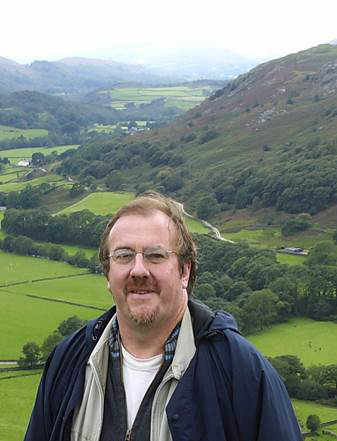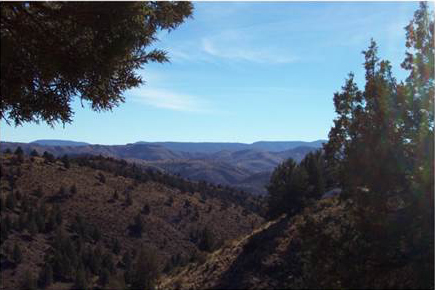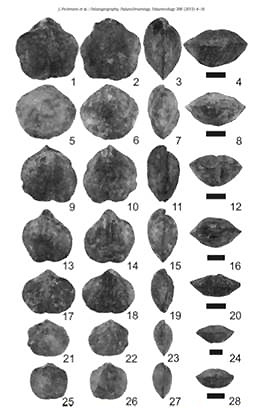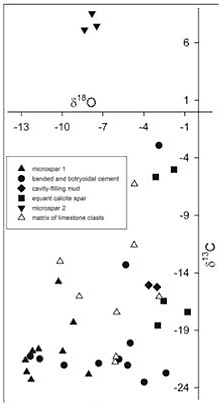Dr. Michael Sandy
 Department of Geology
Department of Geology
University of Dayton
Brachiopod Shell Beds as Indicators of Ancient Hydrocarbon Seeps: Assessing their Geological, Paleoecological, Evolutionary and Biostratigraphical Significance
Dr. Michael Sandy studies fossilized bivalved organisms (brachiopods), which were abundant in seas and oceans of the Mesozoic Era (248 to 65 million years ago). Individual brachiopod genera help to separate different sedimentary deposits, as these animals had distinctive environmental preferences. For example, deep-water ancient hydrocarbon seep deposits would contain different brachiopod genera than those found in shallow-water sedimentary rocks.
According to Dr. Sandy, "I first became interested in geology when my brother and father collected fossils from a cliff along the coast of Dorset, England." His PRF grant has enabled him to collaborate with researchers at the University of Vienna and the University of Oslo, and to carry out field sampling in diverse areas of the globe.
PRF-supported field work has enabled Dr. Sandy to rediscover brachiopod-containing limestones in Oregon and California, first mentioned in the scientific literature of the 1940s-1960s. These limestones had been considered unusual since their first discovery, as anomalous deep-water sediments in which other fossils were absent. Stable carbon-isotopic analyses of these limestones indicate they precipitated from oxidized hydrocarbons, thus verifying the hypothesis that Jurassic brachiopod genera (Anarhynchia and Sulcirostra) occurred in hydrocarbon-seep deposits. According to Sandy, finding Anarhynchia in both hydrocarbon seeps and hydrothermal vent deposits "makes this the only post-Paleozoic brachiopod taxon currently identified in both environments."
Currently, Dr. Sandy and his students are analyzing samples from a series of recently-discovered hydrocarbon seeps in Svalbard, in rocks dated at the Jurassic-Cretaceous boundary (142 million years ago) during the Mesozoic Era. In addition, work continues on Cretaceous-aged sedimentary rock samples from northern Tibet, in limestones with stable Carbon-isotopic values representing oxidized hydrocarbons. This marks the fourth record of the Cretaceous brachiopod genus Peregrinella in hydrocarbon seep deposits, suggesting that this genus was restricted to ancient hydrocarbon seep environments.
His students have participated in sample processing, preparing serial sections to identify brachiopod species, and analyzing stable-isotopic data of the sedimentary rocks in which these fossils are found. Dr. Sandy finds it rewarding to facilitate research experiences for undergraduates, and commented that his ACS PRF grant "allows students to become immersed in all aspects of the research experience, allowing them to consider more thoughtfully their vocation as a scientist."
After earning his doctorate in Geology from Queen Mary College of the University of London, and a post-doctoral fellowship at the University of Aberdeen, Scotland, Sandy joined the faculty of the University of Dayton in 1987. In addition to teaching Geology and Environmental Science courses and general education courses for Dayton undergraduates, he runs graduate workshops for teachers, focusing on local geological resources. He is a recipient of the College of Arts and Sciences Outstanding Scholarship Award, and the University of Dayton Alumni Award for Scholarship. According to Sandy, "the geologic record abounds with evidence of large-scale change, and it is my hope to provide to students in my classes a sense of the connection between the present-day and the ancient earth."
Grant #51198-UR8: Read Sandy's Annual Report

 View of the Aldritch Mountains, east-central Oregon, from which assemblages of brachiopods associated with hydrocarbon seeps have been nidentified including the genera Sulcirostra and Anarhynchia from Early Jurassic carbonates in clastic-dominated sequences.
View of the Aldritch Mountains, east-central Oregon, from which assemblages of brachiopods associated with hydrocarbon seeps have been nidentified including the genera Sulcirostra and Anarhynchia from Early Jurassic carbonates in clastic-dominated sequences. Specimens of the brachiopod Sulcirostra from east-central Oregon associated with hydrocarbon seep environments. Scale bar = 1 cm. From Peckmann et al. 2013
Specimens of the brachiopod Sulcirostra from east-central Oregon associated with hydrocarbon seep environments. Scale bar = 1 cm. From Peckmann et al. 2013 Isotope plot for Sulcirostra locality, Oregon. From Peckmann et al. 2013
Isotope plot for Sulcirostra locality, Oregon. From Peckmann et al. 2013 Mudstone packed with specimens of the Early Jurassic brachiopod Anarhynchia (US quarter coin for scale 2.42 cm in diameter). This brachiopod genus appears to be unique among Mesozoic brachiopods, as the only genus so far recorded from hydrocarbon seeps and hydrothermal vents.
Mudstone packed with specimens of the Early Jurassic brachiopod Anarhynchia (US quarter coin for scale 2.42 cm in diameter). This brachiopod genus appears to be unique among Mesozoic brachiopods, as the only genus so far recorded from hydrocarbon seeps and hydrothermal vents.










